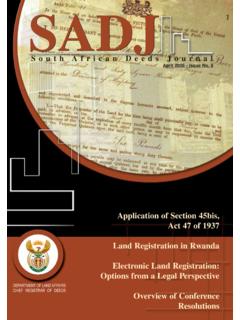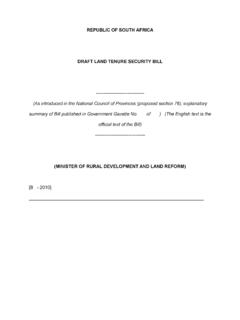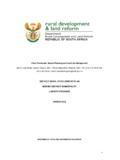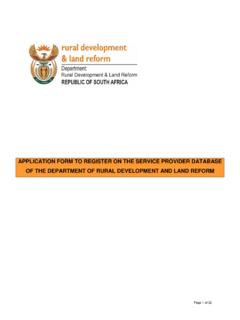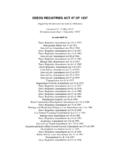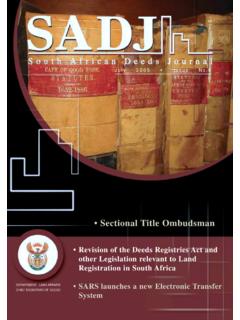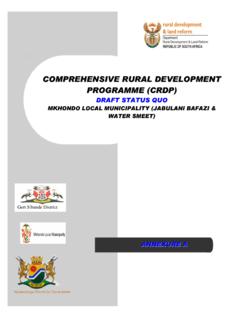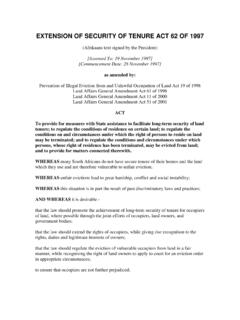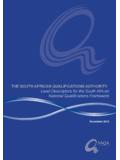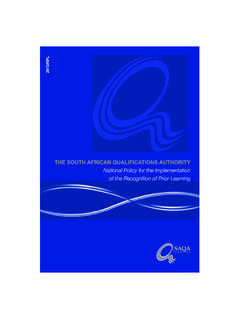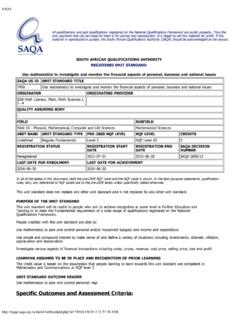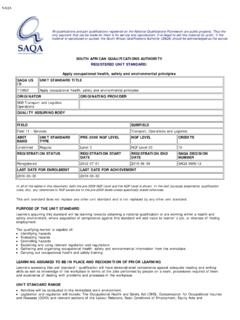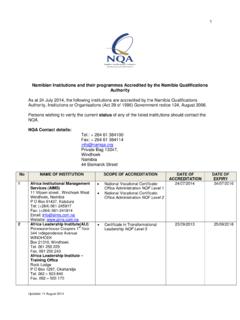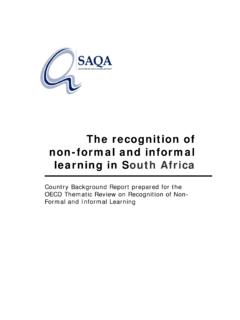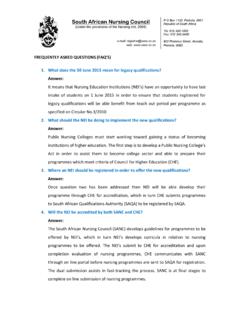Transcription of SOUTH AFRICAN QUALIFICATIONS AUTHORITY
1 All QUALIFICATIONS and part QUALIFICATIONS registered on the National QUALIFICATIONS Framework are public property. Thus the only payment that can be made for them is for service and reproduction. It is illegal to sell this material for profit. If the material is reproduced or quoted, the SOUTH AFRICAN QUALIFICATIONS AUTHORITY (SAQA) should be acknowledged as the source. SOUTH AFRICAN QUALIFICATIONS AUTHORITY REGISTERED qualification : National Certificate: Building and Civil Construction SAQA QUAL ID qualification TITLE 65409 National Certificate: Building and Civil Construction ORIGINATOR ORIGINATING PROVIDER SGB Building Construction QUALITY ASSURING BODY CETA - Construction Education and Training AUTHORITY qualification TYPE FIELD SUBFIELD National Certificate Field 12 - Physical Planning and Construction Building Construction ABET BAND MINIMUM CREDITS OLD NQF LEVEL NEW NQF LEVEL QUAL CLASS Undefined 140 Level 3 NQF Level 03 Regular-Unit Stds Based REGISTRATION STATUS SAQA DECISION NUMBER REGISTRATION START DATE REGISTRATION END DATE Reregistered SAQA 0480/09 2009-07-01 2012-06-30 LAST DATE FOR ENROLMENT LAST DATE FOR ACHIEVEMENT 2013-06-30 2016-06-30 In all of the tables in this document, both the old and the new NQF Levels are shown.
2 In the text (purpose statements, qualification rules, etc), any reference to NQF Levels are to the old levels unless specifically stated otherwise. This qualification replaces: Qual ID qualification Title Old NQF Level New NQF Level Min Credits Replacement Status 20919 National Certificate: Construction Painting Level 3 NQF Level 03 120 Complete 20815 National Certificate: Construction Tiling Level 3 NQF Level 03 120 Complete 20814 National Certificate: Construction Plastering Level 3 NQF Level 03 120 Complete 22670 National Certificate: Construction Carpentry Level 3 NQF Level 03 177 Complete 22671 National Certificate: Construction Masonry Level 3 NQF Level 03 120 Complete PURPOSE AND RATIONALE OF THE qualification Purpose: Typically, qualifying learners are employed in the construction sector as painters, tilers, plasterers, masons, joiners, carpenters, roofers, or are self-employed as micro-enterprise owners who provide services to construction contractors and members of the public ( private households).
3 Consequently, this employment sector consists of many small and micro-enterprises. Qualifying learners will be able to: Plan construction activities using mathematical principles. Communicate with relevant persons. Plan construction activity. Establish work area. Execute construction activity. Rationale: As a result of past legacies, many practitioners within the building construction sector were denied career advancement and possible recognition as qualified tradesmen. This was as a direct result of poor educational opportunities at some schools, leading to a lack of entry to formal training institutions. This qualification : Encourages individual entrepreneurship and job creation. Supports redress and provide access to employment opportunities. Promotes career advancement and further learning.
4 Results in transformation/social upliftment of individuals, communities and the SOUTH AFRICAN society at large. Most learners taking this qualification have not had access to structured skills training in the past, and therefore their competence has not been formally recognised. Although they may have been economically active within the area of construction building and civil construction for many years, most unqualified construction painters, tilers, plasterers, masons, joiners, carpenters, roofers have gained their experience in workplaces where little attention was paid to efficient, correct performance within acceptable time/production rates. The qualification not only allows qualifying learners to gain access to the formal construction sector, but also recognises any previously acquired competence that current workers in the sector may hold and improves their employability prospects.
5 Personal career development and job satisfaction, social and economic transformation not only of persons who are skilled in building and civil construction, but of their local communities and the national economy, are further benefits to be derived from the skills enhancement gained through achievement of this qualification . This qualification will support the creation of a larger community of competent building and civil construction workers and ensure that this sector of the national economy is positively sustained. The range of competencies achieved by learners who successfully complete this qualification is transferable to other areas of training and fields of operation, thereby providing a basis for further learning in the construction sector, as well as possibilities of transferring into other fields of economic activity/employment.
6 The construction sector requires a specific focus on quality management to ensure implementation compliant with Health and Safety Regulations. To ensure sustainability and a positive image of their businesses, employers demand high performance standards and quality workmanship. Qualified construction building and civil construction workers will deliver services of competitive quality; their earning ability will be increased. This qualification may be achieved through any of the (four) routes, which includes apprenticeship, learnership, internship, RPL. To successfully complete this qualification , the learner must spend a minimum time in the workplace and will be completed in this qualification over an 18-months period. LEARNING ASSUMED TO BE IN PLACE AND RECOGNITION OF PRIOR LEARNING It is assumed that learners are already competent in the following: Communication at NQF Level 2.
7 Mathematical Literacy at NQF Level 2. Recognition of Prior Learning: Pre-assessments in both the Fundamental and Core areas of learning associated with this qualification will be conducted on learners prior to entry into the qualification . Successful demonstration of competence against all criteria contained in unit standards, against which prior learning is measured, will culminate in the award of credits to the learner. Learners' will not be required to repeat learning in those areas where prior learning is recognised and accredited. The Recognition of Prior Learning process will also be applied where learners', who have achieved this qualification , wish to continue their further learning and enter other trades at NQF Level 3. Access to the qualification : Access to the qualification is open, except where there are restrictions placed on learners, based on their physical ability to adhere to legal occupational health, safety and environment standards that may prevent them from gaining access to this qualification .
8 RECOGNISE PREVIOUS LEARNING? Y qualification RULES All the following Unit Standards are compulsory: The total of 36 credits in Fundamental are compulsory. The total of 52 credits in the Core are compulsory. The total of 52 credits must be chosen from the Elective category to achieve the total of 140 credits for the full qualification . The choices exercised by the learners will be determinant upon their choice of specialization as indicated below: For the Painting specialisation the following unit standards must be chosen: ID 261666: Prime and apply paint to surfaces, NQF Level 3, 18 Credits. ID 261697: Prepare surfaces for painting, NQF Level 3, 20 Credits. The additional 22 credits required for the achievement of the total 130 credits of the qualification should be chosen from the rest of the elective category.
9 For the Tiling specialisation the following unit standards must be chosen: ID 261665: Prepare surfaces and apply tiles, NQF Level 3, 20 Credits. The additional 40 credits required for the achievement of the total 130 credits of the qualification should be chosen from the rest of the elective category. For the Plastering specialisation the following unit standards must be chosen: ID 261657: Plaster surfaces, NQF Level 3, 12 Credits. ID 9971: Apply screeds to a concrete floor, NQF Level 3, 15 Credits. ID 9969: Prepare for plastering, NQF Level 3, 15 Credits. The additional 6 credits required for the achievement of the total 130 credits of the qualification should be chosen from the rest of the elective category. For the Masonry specialisation the following unit standards must be chosen: ID 261663: Build masonry superstructures using concrete hollow units, NQF Level 3, 10 Credits.
10 ID 261659: Build masonry superstructures using solid units, NQF Level 3, 20 Credits. ID 14662: Set out, excavate, cast concrete strip foundations and build foundation walling, NQF Level 3, 6 Credits. The additional 24 credits required for the achievement of the total 130 credits of the qualification should be chosen from the rest of the elective category. For the Carpentry specialisation the following unit standards must be chosen: ID 14674: Clad roof structures, NQF Level 3, 16 Credits. ID 14676: Erect roof trusses, NQF Level 3, 16 Credits. ID 14673: Install finishing components, NQF Level 3, 16 Credits. The additional 12 credits required for the achievement of the total 130 credits of the qualification should be chosen from the rest of the elective category. For the Concrete Formwork specialisation the following unit standards must be chosen: ID 14226: Fabricate, erect and strip formwork for straight walls, columns and bases, NQF Level 3, 15 Credits.

